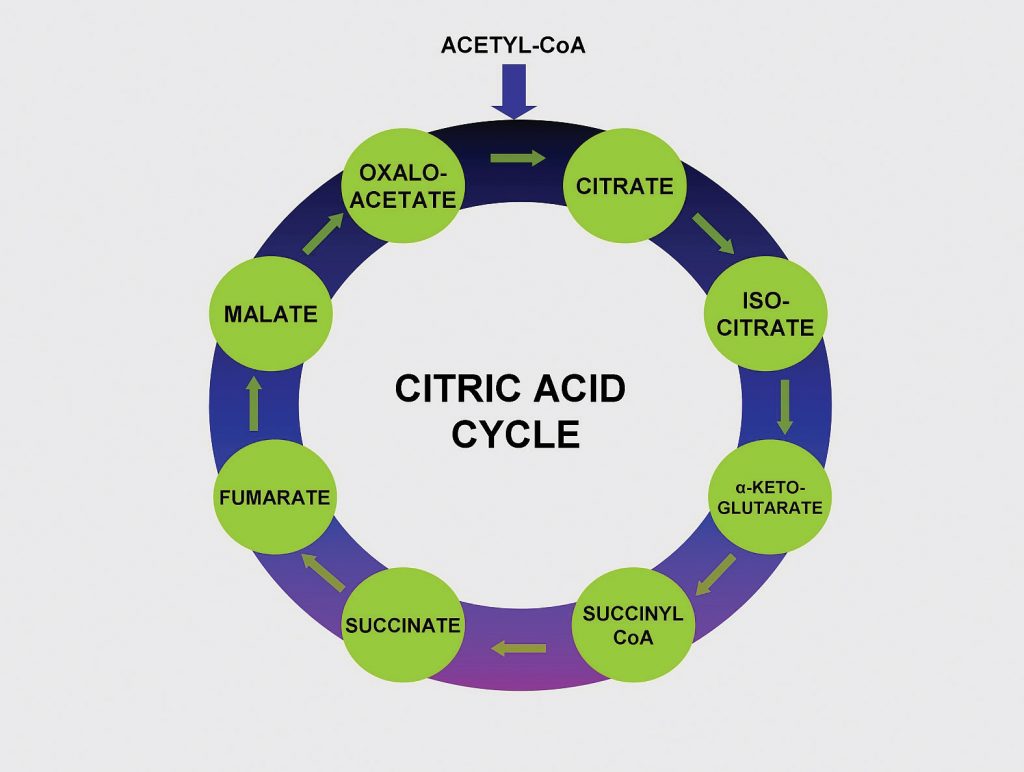Chapter 11: Micronutrients in Metabolism
11.4 Pantothenic Acid (Vitamin B5)
University of Hawai‘i at Mānoa Food Science and Human Nutrition Program
Pantothenic Acid (B5)

Pantothenic acid forms coenzyme A, which is the main carrier of carbon molecules in a cell. Acetyl-CoA is the carbon carrier of glucose, fatty acids, and amino acids into the citric acid cycle (Figure 11.41). Coenzyme A is also involved in the synthesis of lipids, cholesterol, and acetylcholine (a neurotransmitter). A pantothenic acid deficiency is exceptionally rare. Signs and symptoms include fatigue, irritability, numbness, muscle pain, and cramps. You may have seen pantothenic acid on many ingredients lists for skin and hair care products; however there is no good scientific evidence that pantothenic acid improves human skin or hair.
Dietary Reference Intakes
Because there is little information on the requirements for pantothenic acid, the Food and Nutrition Board (FNB) has developed Adequate Intakes (AI) based on the observed dietary intakes in healthy population groups. The AI for different age groups for pantothenic acid are listed in Table 11.41 “Dietary Reference Intakes for Pantothenic Acid “.
Table 11.41 Dietary Reference Intakes for Pantothenic Acid[1]
| Age Group | AI Males and Females (mg/day) |
| Infants (0–6 months) | 1.7 |
| Infants (7–12 months) | 1.8 |
| Children (1–3 years) | 2 |
| Children (4–8 years) | 3 |
| Children (9–13 years) | 4 |
| Adolescents (14–18 years) | 5 |
| Adults (> 19 years) | 5 |
| Pregnancy | 6 |
| Lactation | 7 |
Dietary Sources
Pantothenic Acid is widely distributed in all types of food, which is why a deficiency in this nutrient is rare. Pantothenic Acid gets its name from the greek word “pantothen” which means “from everywhere”. For the pantothenic acid content of various foods, see Table 11.42 Pantothenic Acid Content of Various Foods”.
Table 11.42 Pantothenic Acid Content of Various Foods[2]
| Food | Serving | Pantothenic Acid (mg) | Percent Daily Value |
| Sunflower seeds | 1 oz. | 2 | 20 |
| Fish, trout | 3 oz. | 1.9 | 19 |
| Yogurt, plain nonfat | 8 oz. | 1.6 | 16 |
| Lobster | 3 oz. | 1.4 | 14 |
| Avocado | ½ fruit | 1 | 10 |
| Sweet potato | 1 medium | 1 | 10 |
| Milk | 8 fl oz. | 0.87 | 8.7 |
| Egg | 1 large | 0.7 | 7 |
| Orange | 1 whole | 0.3 | 3 |
| Whole wheat bread | 1 slice | 0. 21 | 2.1 |
- Source: Dietary Supplement Fact Sheet for Health Professionals: Pantothenic Acid. National Institutes of Health, Office of Dietary Supplements. https://ods.od.nih.gov/factsheets/PantothenicAcid-HealthProfessional/. Updated March 26, 2021. Accessed August 2, 2023. ↵
- Micronutrient Information Center: Pantothenic Acid. Oregon State University, Linus Pauling Institute. http://lpi.oregonstate.edu/mic/vitamins/pantothenic-acid . Updated in July 2013. Accessed October 22, 2017.1 ↵
Amino acids are the building blocks of proteins, simple subunits composed of carbon, oxygen, hydrogen, and nitrogen.
Adequate Intake are created for nutrients when there is insufficient consistent scientific evidence to set an EAR for the entire population.

